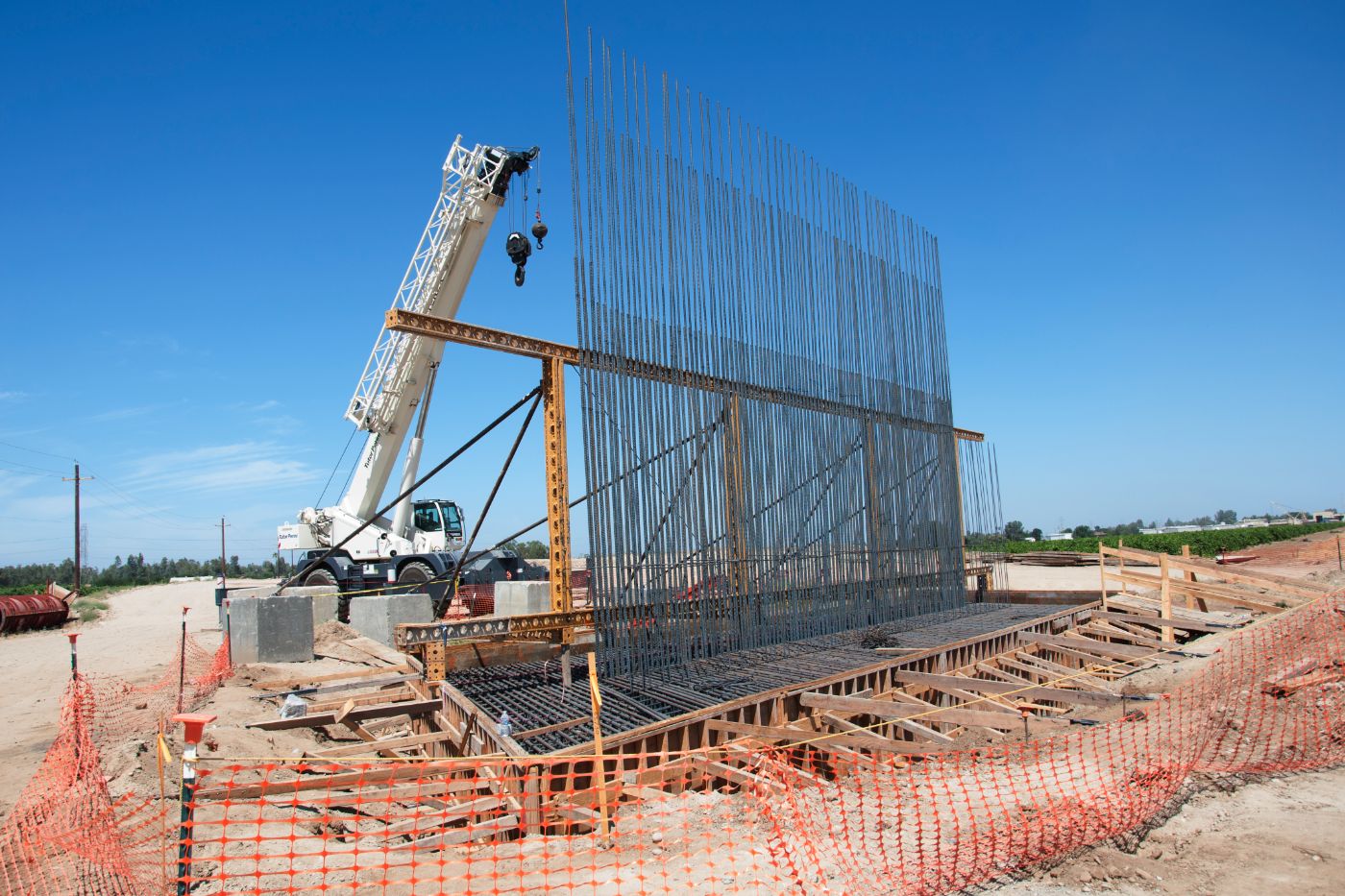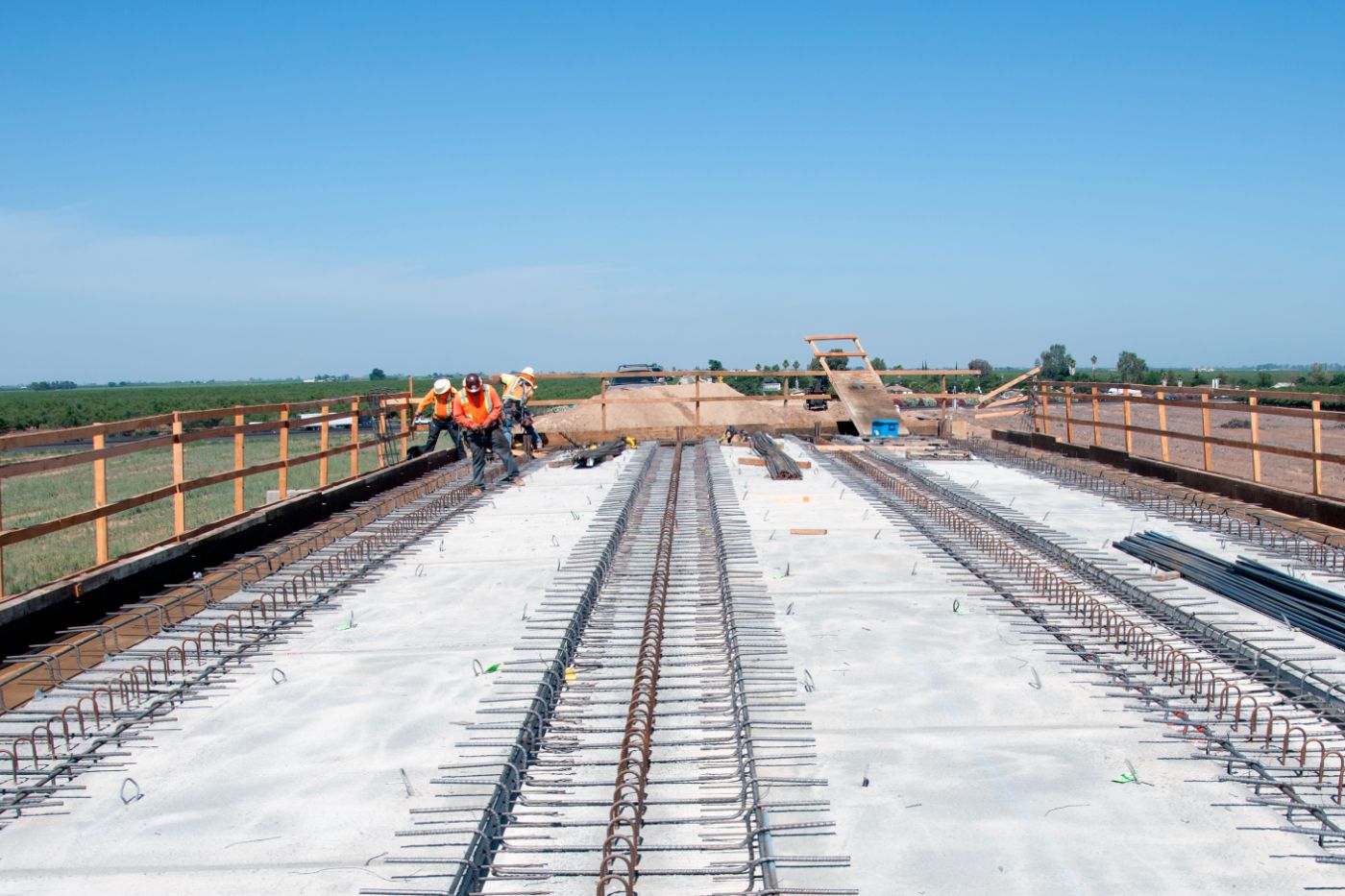July 2018 Edition
Girder Facility Under Construction

Rising from a field just outside of Hanford is a facility the likes of which you won’t find anywhere else in the state.
“They just don’t do this in California,” says foreman Mick Wilson.
This is a girder manufacturing facility built by Construction Package 2-3 design builder Dragados-Flatiron Joint Venture (DFJV). What makes this facility so unique? The speed at which the girders can be created.
“If you did it right, you could do a whole bridge in one week here,” says Wilson. In fact, Wilson explains that depending on length, as many as eight girders could be made all at one time. It’s that capacity that separates the facility from any others in the state and a capacity that will be needed for this stretch of the high-speed rail program.
“We’re going to be building around 1,300 different kinds of beams plus almost half a million precast slabs,” explains project manager Juan Gasca. He says the facility was originally conceived in late 2017 when DFJV couldn’t find a company to meet its needs and schedule.
By March of 2018, the facility was under construction with the help of several small businesses across the state.
“Small suppliers for tools and different hardware companies,” explains Gasca. “All the electrical for the plant is being installed by Preferred Power Solution, it’s a small woman-owned company from Bakersfield. All the rebar in the plant is being installed by Martinez Steel, a small company.”
And it’s not just the businesses that are benefiting. Gasca estimates that 95 percent of the 25-30 people working at the facility are from the area. That includes batch plant operator Javier Velasquez, who has called Hanford home since he was 20.
Velasquez has worked in construction for three decades but says he’s hardly ever worked this close to home, working around the state and the country.
“On the weekends we’d come home, like if we work in the Bay Area, San Francisco, whatever. But when we work out of state maybe (we’d) just come home once a month… maybe once every three months, so it’s kind of hard.”
So what’s it like working so close to home?
Velasquez says he has the opportunity to tackle the honey-do list that has grown quite lengthy after all these years. Still, for him, there truly is no place like home.
“This feels like it’s not work. It feels good, it feels real good.”
Updates Per Project

Featured Project: Road 27
At the overcrossing for Road 27 in Madera County, crews are busy preparing for the placement of concrete girders next month. Here at the northern end of Construction Package 1, the Road 27 overcrossing will take traffic over the high-speed rail line and existing tracks for BNSF.
The Road 27 overpass is a unique structure compared to the others currently being constructed in Madera County. Due to the geometry of Road 27 as it crosses the BNSF and high-speed rail corridor, the spans of this bridge are long.
Design-builder Tutor-Perini/Zachry/Parsons (TPZP) is using precast spliced girders for the superstructure to achieve the distances needed. Shorter precast girders are set on temporary falsework bents. The girders are then post-tensioned and the ends enclosed in concrete to unify the superstructure. Ultimately, the bridge will be over 700 feet long with the longest span stretching 198 feet.

Davis Avenue Geotech Testing
Just west of State Route 43 in south Fresno County, crews conduct geotechnical analysis on test piles for a future overcrossing for Davis Avenue. The test piles are driven into the ground and then subjected to forces to see how the soils react. Designers will use the data collected to determine how to construct the future overcrossing that will take Davis Avenue traffic over the high-speed rail line.

Fresno Trench & SR 180 Passageway
At the Fresno Trench beneath State Route 180 (SR 180), the excavation and shotcrete operation is ongoing. On one side of the trench, a crew sprays shotcrete over rebar to form the trench wall, while on the other side, another worker sprays the new surface with a curing compound to help the concrete set properly. Shotcrete is a type of concrete that is typically sprayed over rebar or metal mesh to keep dirt or material in place and is often used in constructing backyard pools. Crews have approximately 30 more feet to excavate before they reach the bottom of the trench where a concrete box that will carry the trains will be constructed. When complete, the trench will cross under SR 180, a rail spur and the Dry Creek Canal.

San Joaquin River Viaduct
Craft workers pour concrete for the pergola deck structure that will carry trains over the existing freight rail lines at the San Joaquin River Viaduct. On the south bank of the San Joaquin River crews are also busy finishing up construction of pier caps to tie together the few remaining support columns. The cast-in-place construction of the deck is also progressing, tying all the individual components of the structure together. The completed viaduct will form one of the largest structures on this first phase of the high-speed rail project.

Cedar Viaduct
At the Cedar Viaduct, construction crews have begun to extend the structure across State Route 99 (SR 99) south of Fresno. Drilling for support pier foundations is now well underway on either side of the highway and soon will also take place in the highway median. Shafts are being drilled nearly 90 feet deep and will be filled with rebar cages and concrete. The viaduct will eventually be connected to the Muscat Viaduct a little further to the south. One of the largest structures on Construction Package 1, the Cedar Viaduct will be about three-quarters of a mile long when it’s complete.

Avenue 15 Grade Separation
At Avenue 15, just east of Road 29 in Madera County, the western abutment construction for the Avenue 15 overpass continues. Dozens of shafts have been drilled, each one is three feet in diameter and 70 feet deep. The east side will have a cast-in-place wall on either side of the abutment, while the west side of the structure will have pre-cast Mechanically Stabilized Earth (MSE) wall panels to retain the fill on the abutment’s north and south sides. The piers for a supporting bent structure have been poured and next falsework will be erected to construct the bent cap. Eventually, concrete girders will link the abutments with the supporting bent to form the superstructure of the bridge.

Avenue 8 Grade Separation
At Avenue 8 in Madera County, the precast deck panels, which act as the underside (or soffit) of the bridge deck, have been set and crews are tying deck rebar for a single span bridge that will cross the high-speed rail alignment east of State Route 99. The block retaining walls have been completed on either side of the abutments and fill dirt placed to finish the slope leading up to the bridge.

Avenue 11 Grade Separation
Also in Madera County, crews have constructed the bridge deck for the Avenue 11 overcrossing and are getting it ready for a concrete pour later in July. Pictured above, a crane lifts the paving machine, called a Bidwell, off the deck structure for some routine maintenance. This crossing, a little east of Road 30 ½, will take traffic over the high-speed rail alignment.

Avenue 7 Grade Separation
At Avenue 7 and Road 33 in Madera County, a crane set 10 concrete girders to begin construction of the upper portion of the bridge known as the superstructure. Each girder was 110 feet long and weighed about 105,000 pounds. This crossing will straighten out a bend in Avenue 7 while realigning Road 33 and allowing traffic to cross over the high-speed rail tracks east of State Route 99.